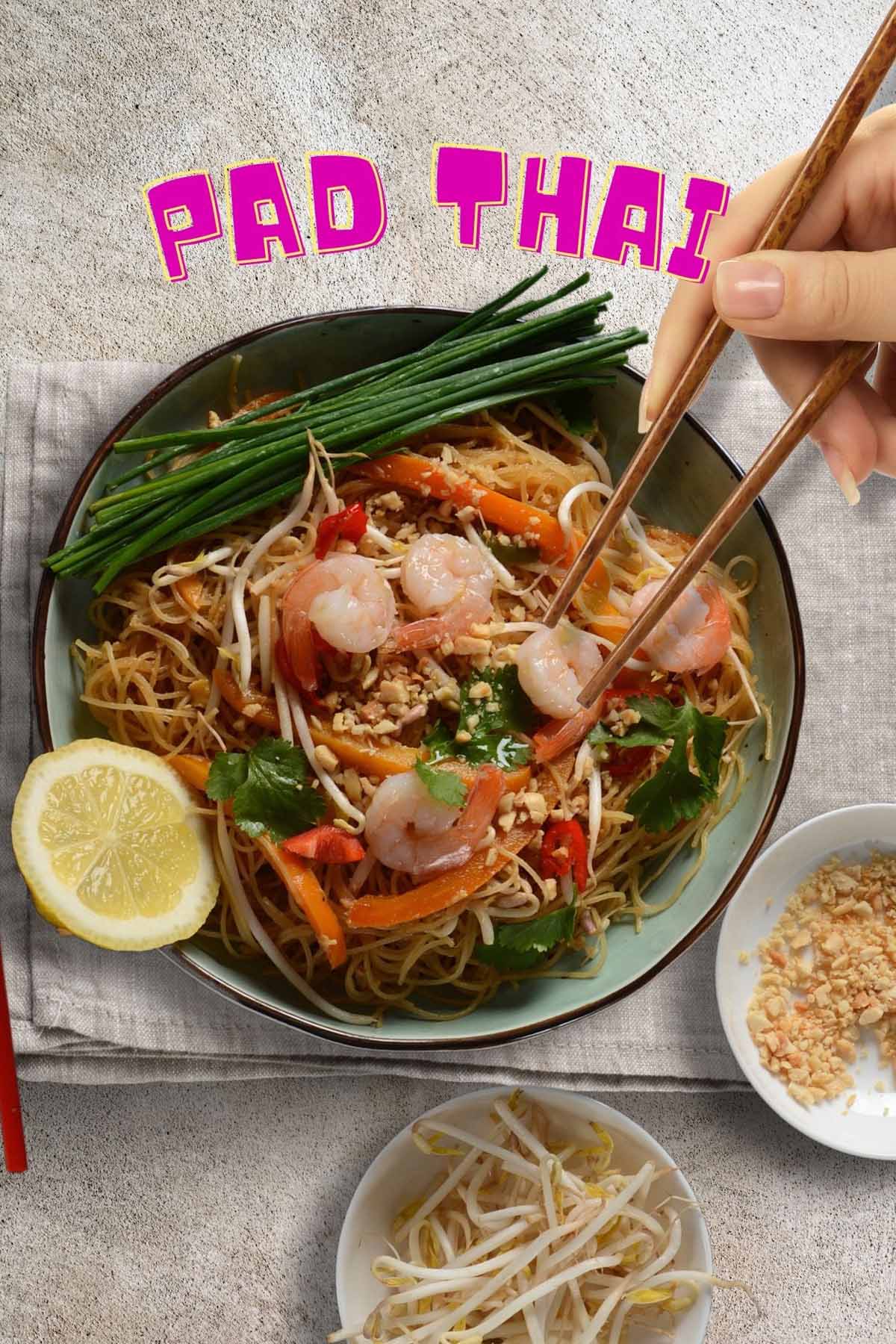Ah, Pad Thai - that scrumptious noodle dish we all can't get enough of. If you've ever had leftovers, you've probably wondered, "how long does Pad Thai last in the fridge?" This blog post covers all you need to know about Pad Thai and its lifespan in your fridge. Discover key insights into the proper storage techniques and tips to ensure your leftovers stay as delightful as they were freshly prepared.
When properly stored, Pad Thai can last in the fridge for about 3 to 5 days. Keep it in an airtight container to maintain the best quality. However, eating it as soon as possible is always best for the freshest taste.
Take aways:
- Proper Storage: When properly stored in an airtight container in the refrigerator, Pad Thai lasts 3 to 4 days.
- Ingredient Impact: The type of ingredients, especially proteins like seafood, chicken, or tofu, significantly affect Pad Thai's shelf life.
- Fridge Temperature is Essential: Maintaining refrigerator temperature below 40°F (4°C) slows bacterial growth and extends Pad Thai's longevity.
Jump to:
What is Pad Thai?

Pad Thai - a name that brings an instant smile to food lovers worldwide. This beautiful concoction of rice noodles, eggs, tofu or shrimp, bean sprouts, peanuts, and a sensational tamarind sauce is a treasure from the streets of Thailand. Many often ask, What does Pad Thai taste like? The answer is a harmonious blend of sweet, sour, salty, and spicy flavors, all wrapped into one irresistible dish.
Pad Thai - a name that brings an instant smile to food lovers worldwide. This beautiful concoction of rice noodles, eggs, tofu or shrimp, bean sprouts, peanuts, and a sensational tamarind sauce is a treasure from the streets of Thailand.
But how does it compare to its close relatives, Pad See Ew and Lo Mein? While exploring the delectable world of Thai and Chinese cuisine, one can't help but ponder the differences between [Pad Thai vs Pad See Ew] and [Pad Thai vs Lo Mein]. Pad Thai and Pad See Ew both hail from Thailand, with Pad Thai standing out as a heartening melody of flavors, a journey to a far-off land right from our dinner tables, while Pad See Ew offers a rich, savory experience with its broader noodles and dark soy sauce.
In contrast, Lo Mein provides a delightful twist to its Chinese origin, bringing in a unique blend of flavors and textures. Exploring these dishes unveils the vast and intricate tapestry of Asian cuisine, inviting us all to indulge in a culinary adventure like no other.
Understanding its Shelf Life
Now, let's flip the coin and see the other side. Picture this - you've made a sumptuous meal of Pad Thai, but after satisfying your cravings, you find you have leftovers. You don't want it to go to waste, but how long can you keep it in the fridge before it loses its charm? That's where we step into the intriguing world of shelf life.
Factors Affecting Shelf Life
Many factors play a role in determining how long Pad Thai can last in the fridge. Everything counts, from the freshness of the ingredients used, the way it's stored, to the temperature of your fridge.
Overview of Pad Thai ingredients.
Pad Thai! Just the name makes my taste buds tingle, doesn't it? It's all about harmony, a balance of sweet, salty, tangy, and spicy flavors. Let's lift the lid and take a look at what goes into this culinary masterpiece.
- Rice Noodles: Light and absorbent, they're the perfect canvas for the vibrant flavors we're painting with.
- Protein: Tofu, chicken, shrimp, or beef, choose your heart's delight.
- Tamarind Paste: This tangy delight gives Pad Thai its characteristic sourness. You can check my Pad Thai Sauce recipe here.
- Fish Sauce: A splash of this adds depth and an umami twist.
- Sugar: A dash of sweetness to balance the tang and spice.
- Chili: Because a little spice never hurt anybody.
- Lime: A squeeze of lime to lift the whole dish.
- Bean Sprouts: They add that lovely crunch and freshness.
- Eggs: Scrambled in, eggs add richness and a lovely texture.
- Green Onions and Cilantro: Nothing like greens to add a fresh and herbaceous note.
- Peanuts: A sprinkle on top adds crunch and a lovely nutty flavor.
You can check my Pad Thai recipe here.
The Role of Ingredients in Shelf Life
Every ingredient in your Pad Thai adds to the taste and is pivotal in how long it lasts. For instance, rice noodles can last quite a while when properly stored. On the other hand, ingredients like tofu or shrimp, being proteins, have a shorter life span.
Meanwhile, sugar, tamarind paste, and fish sauce can act as preservatives, extending the shelf life of your dish. Bean sprouts, however, are quick to spoil, so they may shorten it. That's why understanding the shelf life of individual ingredients is crucial in knowing how long your Pad Thai will last.
A Guide to Food Safety
We've all been there, excitedly opening a container of leftovers, only to be greeted by a funky smell. That's food spoilage for you, my friends. But what exactly causes this less-than-pleasant transformation?
Microorganisms, such as bacteria, yeast, and mold, are the unseen culprits. These tiny life forms are everywhere around us, including our food. Most are harmless, but some can make our food smelly and even make us sick.
Here's what happens: These microbes eat away at our food and break it down. In the process, they produce substances that can change the taste, smell, and appearance of the food – the classic signs of spoilage we're all too familiar with. This process is faster in some foods, like our favorite Pad Thai, mainly when it contains perishable ingredients like tofu or shrimp.
The Role of Refrigeration in Food Storage
The chill environment inside our fridges slows down the growth of these spoilage-causing microbes, giving our food a longer lease on life. But remember, refrigeration doesn't kill these organisms; it just hits their pause button. That's why even refrigerated food only lasts for a while.
Keeping your refrigerator at the right temperature is critical. We're aiming for below 40°F (4°C). Any warmer, and those microbes might just throw a party in there. Also, make sure your Pad Thai is stored in airtight containers. This reduces the exposure to air and further slows down spoilage.
How Long Does Pad Thai Last in the Fridge?
We've cooked and savored and now have some Pad Thai left. How long can we keep it in the fridge before it goes from fabulous to funky? The quick answer is three to four days. That's your window for enjoying the delicious leftovers.
Remember, though, this isn't a hard and fast rule. Many factors can change the timeline. For instance, if your fridge runs a little warmer or if the food sat out for a bit before you refrigerated it, that window might be shorter.
Factors Influencing the Refrigerated Life of Pad Thai
Let's talk about some things that can change how long your Pad Thai lasts.
- Ingredients: As we discussed, ingredients play a significant role. A vegetable-based Pad Thai might last a bit longer than one loaded with shrimp or tofu.
- Temperature: Your fridge's temperature plays a massive role. It must be below 40°F (4°C) to effectively slow bacterial growth.
- Storage Method: How you store your Pad Thai matters. Airtight containers are your best bet. They limit exposure to air and keep your food fresher for longer.
- Time Before Refrigeration: The sooner you get your leftovers in the fridge, the better. If your Pad Thai sits at room temperature for a long time, bacteria can start to multiply, and the shelf life in the fridge will be shorter.
How to Properly Store Pad Thai in the Fridge
Keeping Pad Thai in the fridge is more than tossing it on a shelf. Here's a step-by-step guide on how to store Pad Thai properly and ensure its freshness.
- Cool It Down: Once you've finished eating, let the Pad Thai cool down, but don't leave it out for more than two hours. Bacteria love warm temperatures!
- Choose the Right Container: Opt for an airtight container. This keeps the moisture in and keeps other fridge flavors out.
- Divide and Conquer: If you have a large amount of Pad Thai left, storing it in smaller portions is better. This way, when you're hungry for more, you only need to reheat what you'll eat.
- Set the Fridge Temperature: Ensure your fridge is below 40°F (4°C). This temperature is the safe zone where bacteria growth slows down.
- Refrigerate Promptly: After cooling and packing the Pad Thai, place it in the fridge as soon as possible.
Spotting Spoiled Pad Thai: Know the Signs
Even the tastiest Pad Thai has an expiration date. Here's a comprehensive guide on identifying the signs of spoilage, from funky odors to suspicious colors, and what to do if your Pad Thai has turned.
- Look for Discoloration: If your Pad Thai has darkened or there's any visible mold, it's a sure sign of spoilage.
- Check the Smell: Fresh Pad Thai has a unique, pleasant aroma. If it's starting to smell sour, yeasty, or just "off," trust your nose – it's spoiled.
- Texture Changes: If the noodles have turned mushy or have a slimy layer on the food, it's time to say goodbye.
- Taste It (But Only If You're Not Sure): If the look and smell check out, but you're still unsure, you could taste a bit. However, if it tastes sour or off, spit it out right away!
- When in Doubt, Throw it Out: If you doubt whether your Pad Thai is safe to eat, it's better to err on caution. Remember, it's not worth risking food poisoning.
Ingredient Lifespan: Impact on Pad Thai
Every dish is only as good as its ingredients, and Pad Thai is no different. But how do these components affect the overall shelf life of your dish? And what swaps can we make for longer-lasting goodness? Let's break it down.
Ingredient Impact on Pad Thai's Shelf Life
- Rice Noodles: They are typically pretty shelf-stable, but once cooked, they soften and absorb moisture, which can speed up spoilage. So, enjoying your Pad Thai within a few days of cooking is best.
- Proteins (Chicken, Tofu, Shrimp): These tend to have a shorter shelf life, especially shrimp. They should be eaten within two days of cooking to ensure freshness and avoid potential food poisoning.
- Vegetables: Veggies like bean sprouts and green onions start to wilt and lose their crunch after a day or two, affecting both taste and safety.
- Sauce (Tamarind, Fish Sauce, Sugar, Lime): These ingredients last pretty well in the fridge, but once mixed into the dish, they must also be eaten within a few days to avoid spoilage.
Ingredient Swaps for a Longer Shelf Life
Now, if we're talking about making your Pad Thai last longer without losing its character, we've got some clever ingredient swaps:
- Protein Swaps: Swap out shrimp for chicken or tofu, which generally last longer.
- Vegetable Swaps: Swap bean sprouts (which wilt quickly) for cabbage or carrots that hold up better over time.
- Fresh Herbs Later: If you plan on storing the dish, add fresh herbs like cilantro and chopped peanuts when ready to eat.
Reheating: Bringing Your Pad Thai Back to Life
Alright, you've mastered storing your Pad Thai in the fridge, but now comes another challenge - how to reheat it safely and deliciously. Let's get right into it.
Step-by-Step: Reheating Your Pad Thai
Reheating your Pad Thai isn't a complex science, but a few steps can make all the difference between a soggy mess and a meal that's almost as good as fresh.
- Microwave: The fastest method, but be careful. Spread your Pad Thai evenly on a microwave-safe dish. Heat it on medium power for 1-2 minutes, stir it well, then another minute or two until it's hot all through.
- Stovetop: This takes a bit more time but can deliver a better texture. Warm a bit of oil in a pan, toss in your Pad Thai, and stir-fry it on medium heat until it's warmed.
Precautions for Reheating Pad Thai
Okay, so now you know how to reheat your Pad Thai. But wait! Here are a few things to keep in mind:
- Always Check the Temperature: This isn't just to ensure your food is hot enough to enjoy, but also to ensure it's safe. Use a food thermometer to ensure your Pad Thai hits at least 165°F, which kills most bacteria.
- Beware the Danger Zone: Remember that 40°F to 140°F range? Food should not stay in this temperature range for more than two hours. So, don't let your Pad Thai sit at room temperature long before reheating.
- Reheat Only Once: Each time you reheat food, you risk increasing bacterial growth. It's safest to only reheat what you plan to eat right away.
Read:
Frequently Asked Questions
Let's delve into some common questions people have about storing Pad Thai. This will help clear up any confusion and make your mealtime a breeze.
In the fridge, Pad Thai will last about 3-5 days. Be sure to store it in an airtight container to keep it fresh as long as possible.
Spoiled Pad Thai may have a sour smell or may develop a slimy or moldy texture. If you see any of these signs, it's best to throw it out.
Absolutely! If stored properly in a freezer-safe container, Pad Thai can last for up to two months in the freezer.
While the flavor may change slightly due to the chilling process, refrigerated Pad Thai still tastes delicious, especially when reheated correctly!
You can reheat Pad Thai either on the stovetop with a bit of oil or in the microwave. Just be sure it reaches a safe internal temperature of 165°F.
Yes, repeated reheating can increase bacterial growth. It's best only to reheat the amount you plan to eat.
Yes, ingredients like fresh shrimp or chicken may shorten the shelf life due to their own perishability. Opt for plant-based proteins like tofu for longer-lasting Pad Thai.
No, food left out in the "danger zone" (40°F to 140°F) for more than 2 hours may grow harmful bacteria. Always refrigerate leftovers promptly.
Storing it in an airtight container, keeping your fridge at the correct temperature, and using fresh ingredients can all help extend the shelf life of your Pad Thai.
A sour smell is a sign of spoilage. It's always better to be safe and not consume food that may have gone bad. When in doubt, throw it out!




